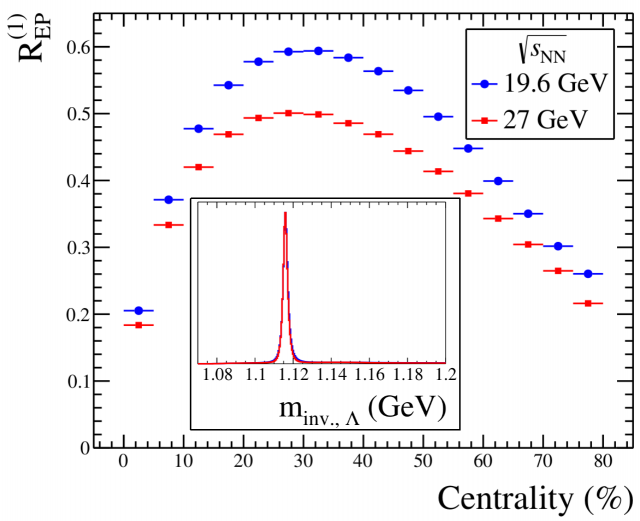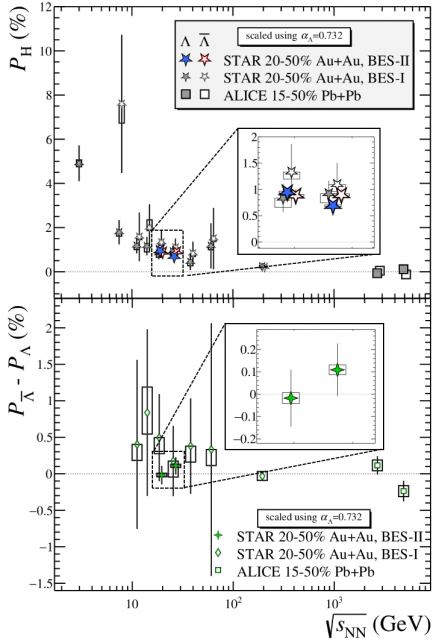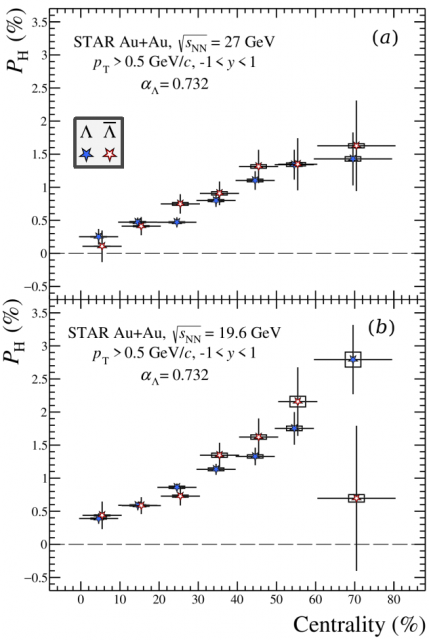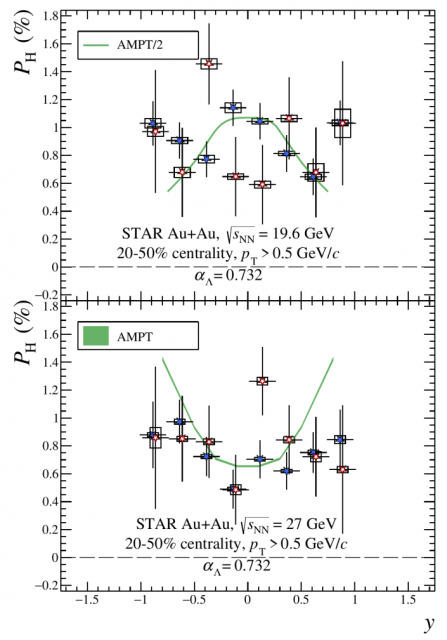Global polarization of Λ and ̄Λ hyperons in Au+Au collisions at √sNN = 19.6 and 27 GeV
Updated on Thu, 2023-05-04 10:17. Originally created by adams92 on 2022-05-02 09:17.
Preview Slides
Attached; see bottom
Primary Authors
Joseph R. Adams, Egor Alpatov, Michael Lisa, Grigory Nigmatkulov
Title
Global polarization of Λ and ̄Λ hyperons in Au+Au collisions at √sNN = 19.6 and 27 GeV
Abstract
In relativistic heavy-ion collisions, there exists a global spin alignment of $\Lambda$ and $\LamBar$ hyperons along the direction of the system angular momentum. Measurements across a broad range of collision energies have demonstrated a trend of increasing $\PHyper$ with decreasing $\sNN$. These measurements have suggested a larger polarization of $\LamBar$ hyperons than $\Lambda$ hyperons, with this splitting becoming larger at lower collision energies. Such a splitting would be consistent with a late-stage magnetic field sustained by the quark-gluon plasma formed in the collision. High-statistics data sets at mid-range collision energies would serve to precisely measure this magnetic field. The results presented in this study find no significant splitting at the collision energies of $\sNN=19.6$ and 27~GeV using the STAR detector. We find the upper limit of the na\"ive extraction of quark-gluon plasma magnetic susceptibility to be on the order of that predicted by lattice quantum chromodynamics calculations. Still, the available statistics and improved acceptance of the STAR detector, with recent upgrades, allow for the study of $\PHyper$ with respect to collision centrality, transverse momentum, and rapidity. Notably, multiple model calculations following a variety of different assumptions have each predicted a strong dependence on rapidity in this collision-energy range, and the suspected dependence has been used to explain various phenomena; however, no such dependence has been yet observed. With our current acceptance and uncertainties, we observe no such dependence, challenging these predictions and their consequences.

Target Journal
Physical Review C
Figures
 Figure 1
Figure 1
 Figure 2
Figure 2
 Figure 3
Figure 3
 Figure 4
Figure 4
 Figure 5
Figure 5
Conclusions
Note: "Q"s are questions brought up during the preview, "A"s are answers provided during the preview, and "R" are follow-up responses addressed after the preview.
Code
The code for reading PicoDsts and generating "FemtoDsts" can be found at /star/u/adams92/Desktop/SplittingAnalysisCode/RCF/ and the code for reading the "FemtoDsts" on your computer to generate results can be found at /star/u/adams92/Desktop/SplittingAnalysisCode/Local/
Attached; see bottom
Primary Authors
Joseph R. Adams, Egor Alpatov, Michael Lisa, Grigory Nigmatkulov
Title
Global polarization of Λ and ̄Λ hyperons in Au+Au collisions at √sNN = 19.6 and 27 GeV
Abstract
In relativistic heavy-ion collisions, there exists a global spin alignment of $\Lambda$ and $\LamBar$ hyperons along the direction of the system angular momentum. Measurements across a broad range of collision energies have demonstrated a trend of increasing $\PHyper$ with decreasing $\sNN$. These measurements have suggested a larger polarization of $\LamBar$ hyperons than $\Lambda$ hyperons, with this splitting becoming larger at lower collision energies. Such a splitting would be consistent with a late-stage magnetic field sustained by the quark-gluon plasma formed in the collision. High-statistics data sets at mid-range collision energies would serve to precisely measure this magnetic field. The results presented in this study find no significant splitting at the collision energies of $\sNN=19.6$ and 27~GeV using the STAR detector. We find the upper limit of the na\"ive extraction of quark-gluon plasma magnetic susceptibility to be on the order of that predicted by lattice quantum chromodynamics calculations. Still, the available statistics and improved acceptance of the STAR detector, with recent upgrades, allow for the study of $\PHyper$ with respect to collision centrality, transverse momentum, and rapidity. Notably, multiple model calculations following a variety of different assumptions have each predicted a strong dependence on rapidity in this collision-energy range, and the suspected dependence has been used to explain various phenomena; however, no such dependence has been yet observed. With our current acceptance and uncertainties, we observe no such dependence, challenging these predictions and their consequences.

Target Journal
Physical Review C
Figures
 Figure 1
Figure 1 Figure 2
Figure 2 Figure 3
Figure 3 Figure 4
Figure 4 Figure 5
Figure 5Conclusions
- An enhancement of Anti-Lambda polarization over Lambda polarization, suggested in previous experimental studies, would be consistent with a large late-stage magnetic field and offer insight on the magnetic susceptibility of the QGP. Despite the dramatically reduced uncertainties in these measurements of polarization at 19.6 and 27 GeV, we observe no significant splitting between Lambda and Anti-Lambda polarizations. Still, a consistency between these polarizations may indicate a magnetic field due to the phase space and emission-time differences between the Lambda and Anti-Lambda. In these studies we observe no significant splitting. Using a naïve extrapolation of the splitting, we measure an upper limit on the late-stage magnetic field consistent with lattice QCD predictions.
- Precise measurements of Lambda and Anti-Lambda polarizations at 19.6 and 27 GeV, with significances of greater than 6 sigma, are in line with previous observations and provide understanding in the energy dependence of polarization.
- High-statistics data sets at lower energy allow for precision measurements on the rapidity dependence, which has been predicted by models but not yet observed in data. Despite the numerous predictions, which in part would explain the energy dependence of polarization, no significant dependence is observed in either data set.
- The statistics also allow for precision measurements on the transverse-momentum dependence, which may be expected to show a decreasing polarization at high pT. As in other studies, we see no such dependence.
- As we expect from an angular-momentum-driven phenomenon, we observe polarization monotonically increasing with collision centrality.
- 2022 February 14 -- Collaboration Meeting -- "Lambda and Anti-Lambda Polarization at √sNN = 19.6 and 27 GeV" -- slides
- 2021 November 3 -- Bulk Corr/FCV -- "Lambda Polarization at √sNN = 19.6 GeV" -- slides
- 2021 September 14 -- Collaboration Meeting -- "Lambda Polarization at √sNN = 19.6 GeV" -- slides
- 2021 August 11 -- Bulk Corr/FCV -- "Lambda Polarization at √sNN = 19.6 GeV" -- slides
- 2020 July 28 -- Bulk Corr/FCV -- "Lambda Polarization at √sNN = 19.6 GeV" -- slides
- 2019 September 11 -- Bulk Corr/FCV -- "Lambda Polarization at 27 GeV" -- slides
- 2019 August 21 -- Collaboration Meeting -- "Lambda Polarization at 27 GeV" -- slides
- 2019 March 27 -- Bulk Corr/FCV -- "Problems in 2018 production" -- slides
- 2022 February 16 -- Collaboration Meeting -- "Global Λ and Ξ polarization at Au+Au √sNN = 19.6 and 27 GeV" -- slides
- 2021 September 15 -- Collaboration Meeting -- "Hyperon global polarization" -- slides
- 2020 September 17 -- Collaboration Meeting -- "Global hyperon's polarization in Au+Au 27 GeV" -- slides
- 2021 October 19 -- Bulk Corr/FCV -- "Hyperon global polarization at 19.6 GeV" -- slides
- 2020 August 5 -- Bulk Corr/FCV -- "Global hyperon polarization at Au+Au 27 GeV" -- slides
- 2020 July 22 -- Bulk Corr/FCV -- "Global hyperon polarization in Au+Au collisions: 27 GeV update" -- slides
Note: "Q"s are questions brought up during the preview, "A"s are answers provided during the preview, and "R" are follow-up responses addressed after the preview.
Slide 7
Q. The v1 weight is prepared for each centrality bins?
A. Yes.
C. Since this analysis has some technical detail, consider to include such discussion and any EPD performance plot in the paper, e.g. EP resolution.
R. Figure 1 now includes the resolution.
R. Figure 1 now includes the resolution.
Slide 11
Q. TOF was used in the analysis? How was this effect checked?
A. Yes, TOF is used in KFP. 4 different sets (with/without TOF hits of daughters) were checked and no significant difference in the polarization (see slide 41).
Slide 14
Q. Why \overline is needed for PH? Polarization is measured as an ensemble.
R. We have removed the overlines.
Q. Efficiency correction is applied for pT-integrated or y-integrated results? No low-pT particles at forward rapidity as shown in slide 8. That may affect the rapidity dependence.
A. Since no significant pT/y dependence is observed, the correction is not applied. The effect would be negligible.
C. Still good to check it. For example, one can apply larger pT_min cut or narrower y-cut to see how the results change. Or estimate the uncertainty considering the observed/suggested y-dependence in some ways. Because there is “suggestive” trend.
R. The check showed no significant deviations; this is not surprising because (1) statistics are quite limited and (2) there is no significant pT dependence
Q. For the “suggestive trends” in rapidity dependence, two-independent analysis show the same trend?
A. Yes, similar trend was observed.
C. Such detailed comparison plots should be included in the analysis note.
R. Done.
R. Done.
C. If most of Lambdas are pT>0.5 according to the acceptance plot of slide 8, the label should be "pT>0.5” instead of "pT>0.4”.
R. Labels have been changed
R. Labels have been changed
Q. Looking at mid-central data points in the right plots and comparing to BES-I results, BES-II results look smaller a bit. Is this correct?
A. Yes, that’s correct but also the results are consistent.
Q. Any plan to compare with theoretical models?
A. Haven’t considered it. Maybe for rapidity dependence but such a comparison was done in 3 GeV paper.
Slide 15
C. It would be very useful to plot Lambda and anti-Lambda separately and compare to BES-I results, before showing the difference. Not only for the consistency check but the plot can show how much the results are improved in BES-II. At least as a supplemental plot.
R. Figure 2 now shows this polarization plot.
R. Figure 2 now shows this polarization plot.
C. BES-II results have x-error while BES-I does not. Please minimize the errors if there is no actual meaning.
R. Fixed.
R. Fixed.
C. The data points seem to be shifted along x-axis but the shift looks different for 19.6 and 27 GeV. Better to be consistent.
R. Fixed.
R. Fixed.
Slide 17
Q. Any other possible sources for polarization difference? What should we look at this plot (B vs time)
A. Yes, there are many other sources, e.g. baryon chemical potential or freeze-out time/positions, but we start with simple motivation. This measurement provides an upper limit of B-field at freeze-out. As indicated in the B-field plot, lifetime of B-field depends on the conductivity of QGP.
Q. Feed-down correction was applied?
A. Yes for B-field calculation, but not for polarization
Q. How does the helicity efficiency affect the results?
A. The effect is largely cancelled when integrating over azimuthal angle. The generalized method also takes care of it, which is especially important at fixed-target analysis.
Code
The code for reading PicoDsts and generating "FemtoDsts" can be found at /star/u/adams92/Desktop/SplittingAnalysisCode/RCF/ and the code for reading the "FemtoDsts" on your computer to generate results can be found at /star/u/adams92/Desktop/SplittingAnalysisCode/Local/
»
- adams92's blog
- Login or register to post comments
